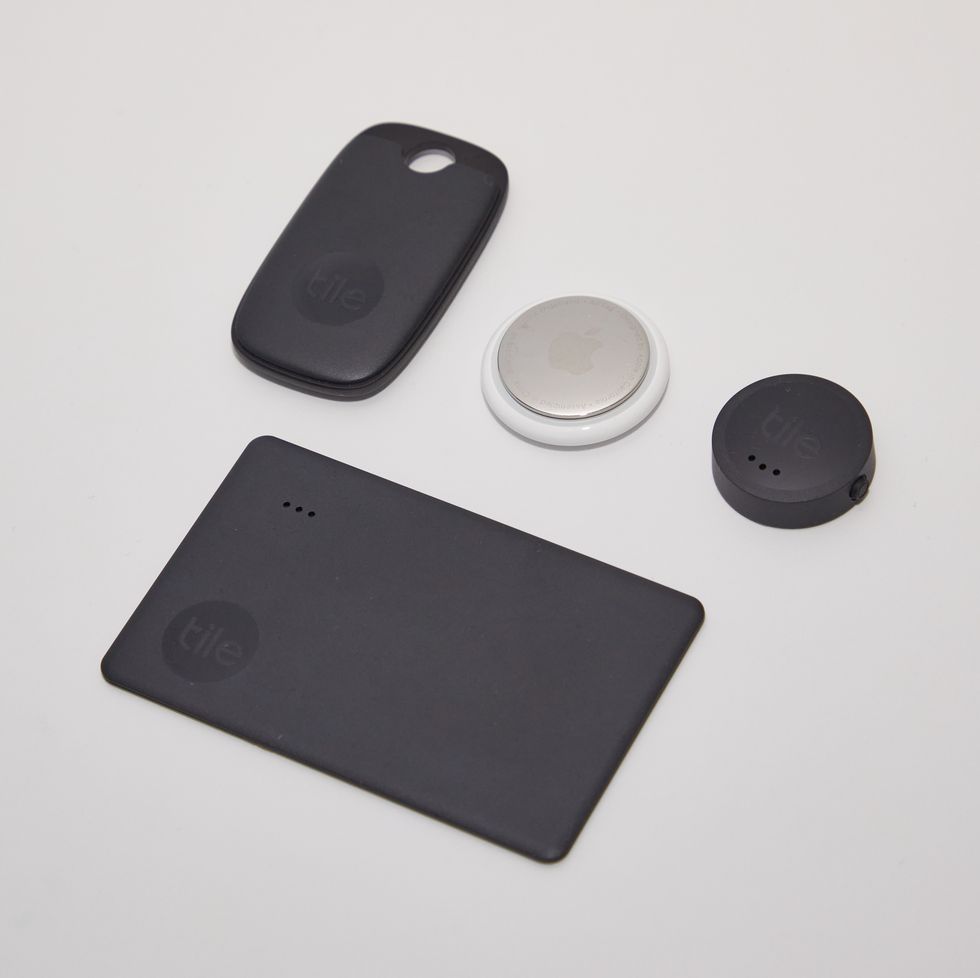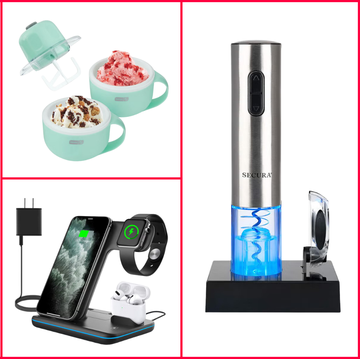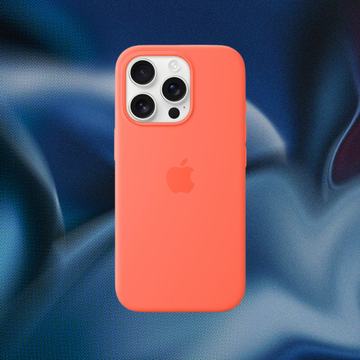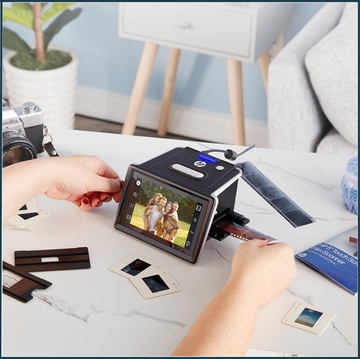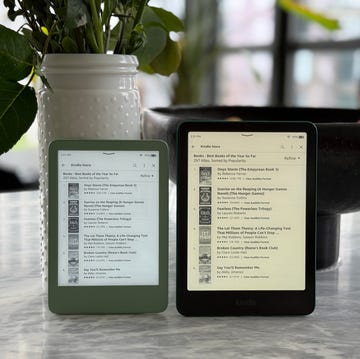Searching for your missing keys, wallet or passport can be stressful when you're in a rush and need to get out the door. To help avoid a scenario that could make you late for work or even miss a flight, consider sticking a Bluetooth tracker onto easy-to-misplace valuables.
These little gadgets are not only lightweight and portable, but they're super easy to use and surprisingly effective at helping you track down missing items. By clipping a Bluetooth tracker onto a backpack or tucking one inside a suitcase, you'll be able to check your tracker's location through an app on your phone and (hopefully) never lose anything again.
The product analysts and engineers at the Good Housekeeping Institute have been testing gadgets like luggage trackers, key finders and smart home devices for years. Most recently, our pros decided to put two of the most popular Bluetooth trackers on the market to the test: Tile and Apple's AirTag. We compared everything from the tracker's price to its ease of set-up, design, app, location accuracy and network to help you choose the best, and most precise, one for you. Here's everything you need to know about Tile vs. AirTag and whether a Bluetooth tracker is worth it.
What Is a Bluetooth Tracker?
Bluetooth trackers leverage Bluetooth technology to monitor where an item is located. Chief Technologist at the Good Housekeeping Institute, Rachel Rothman, explains that they're an excellent choice for helping you recover misplaced or lost items. Depending on the form of tracker you purchase, she suggests either affixing it to valuable devices like phones and computers or slipping them into things like your wallet or bag. "In a best-case scenario, you'll never need to employ them," Rothman says. "In a less-than-ideal scenario, you've got a backup to help you find what you're missing."
These gadgets are not to be confused with GPS trackers, which leverage satellite connections to share real-time location data. Instead, Bluetooth trackers rely on a connection to a Bluetooth-enabled device like a smartphone, tablet or computer to provide location information. Though they're not nearly as accurate or reliable as GPS trackers and operate within a shorter range, they require less battery power and are significantly lighter and more affordable. According to Rothman, most Bluetooth trackers (Tile and AirTag included) are able to trigger an audible alarm when you're within distance of Bluetooth connectivity to help you find the tracker. You can also use their app and its network to help find your items if you're out of range.
For tracking personal items like keys, wallets and suitcases, our pros recommend Bluetooth trackers like AirTag and Tile. But it's important to keep in mind that Bluetooth trackers have their limitations and ultimately won't be nearly as quick or effective at tracking down the location of a lost pet on the move. In such scenarios, dog GPS collars are a much better choice.
Tile vs. AirTag: Compatibility
Apple AirTags are only for iOS users, plain and simple. If you don't own an iPhone or an iPad, you won't be able to use this sleek tracker to keep an eye on your valuables.
Tile's compatibility is much more impressive as it supports both iOS and Android. Whatever phone you have, there's a higher chance it'll support Tile.
Tile vs. AirTag: Pricing
Here's the breakdown:
- One Apple AirTag will cost under $30, or you can save a bit by purchasing a four-pack for around $90.
- Tile trackers are similarly priced, retailing anywhere from $25 to $35 each depending on the one you choose.
Apple AirTag doesn't require a subscription for access to all features, so you don't have to factor in any additional pricing. Unlike Apple, Tile offers an optional subscription, which will drive up its overall cost. Subscribing to Tile Premium costs $2.99 a month or $29.99 a year and grants you access to features like smart alerts, which let you know when you’ve left something behind, as well as 30-day location history.
The pricier Premium Protect plan ($99.99 a year) includes the same features as the Premium plan with an additional $1,000 reimbursement guaranteed if Tile cannot find your lost device. The Premium plan also offers a reimbursement similar to the Premium Protect Plan, but only up to $100. Apple AirTag doesn't offer any form of reimbursement or guarantee if your lost AirTag is never found, so that's something to keep in mind when choosing between the two.
Tile vs. AirTag: Set-up
To set up your Tile tracker, you first have to download the Tile app on your phone. Once you're ready, you'll activate your physical Tile by pressing down on the Tile button, which should play a sound. From there, you'll go through the steps and label your Tiles so you know which one is tracking what. Overall, set-up only took me a few minutes (if that) and felt super easy.
While pairing the Tile to your device is fairly straightforward, I'll admit that it takes even less time to connect an Apple AirTag. The process is so seamless and easy that you barely have to do anything at all — just bring your AirTag close to your iPhone and it'll connect instantly to your Apple ID. Within seconds, you can start using your AirTag and tracking valuables in your Find My app.
Tile vs. AirTag: Design
The Apple AirTag doesn't offer much choice when it comes to design, but we're not too upset about it. It features a cute white and metal button shape that's both lightweight and as sleek as you'd expect any Apple product to be. Though it's annoying that you have to purchase accessories like a key chain holder if you want to attach it to your keys (since the AirTag doesn't come with a keyring hole), we didn't find it too troublesome to stash it inside a purse pocket or inside a suitcase. You can even find suitcases these days that come with dedicated AirTag holders.
Unlike Apple's AirTag, you can purchase a Tile Bluetooth tracker in a variety of shapes and sizes. Tile Slim is comparable in size and shape to a credit card, making it the perfect choice for wallets, while Tile Sticker is the closest to an AirTag in terms of size but features an adhesive backing that you can use to stick it onto devices like remotes, glasses or headphones. Lastly, the Tile Mate (also similar in size to an AirTag, but square) and the larger Tile Pro both come with keyring holes so you can attach them to keychains, clips or collars. The Tile Pro is extremely slim but has a rectangular shape similar to a key fob that feels larger than an AirTag. Though no Tile tracker looks identical, they're all made of a similar material featuring a standard matte black design with a button you can physically press to help you find your phone. The Apple AirTag, on the other hand, is buttonless.
What all these Bluetooth trackers have in common is that they're extremely lightweight and compact. They're also water resistant with an IP67 rating so you don't have to worry if they get a little wet or even submerged in water up to 1 meter for 30 minutes. Apple's AirTag and the Tile Pro both have replaceable batteries that should last a year. Tile Mate, Sticker and Slim have even longer 3-year (yet non-replaceable) battery lives.
Tile vs. AirTag: App
Apple uses the Find My app that's installed on all iPhones and iPads, while Tile uses the Tile app. Though both apps are fairly easy to use, Apple users are likely more familiar with Find My as this same app tracks your other Apple devices like AirPods, smartwatches or MacBooks. It's extremely intuitive and easy to use.
The Tile app is pretty straightforward as well, though not quite as seamless as Apple's Find My. Once you've downloaded it, each one of your Bluetooth trackers will be displayed directly on the main page. Our pros like that you can label each tracker so you know what's what, but the overall experience feels slower and we missed Apple's Precision Finding feature (more details below).
Tile vs. AirTag: Location Accuracy
Both Tile and AirTag rely on Bluetooth Low Energy (BLE) technology to track down your items. Apple supports a technology referred to as Ultra-wideband (UWB), which enables a feature called Precision Finding that's available to those with an iPhone 11 or newer. What's special about Precision Finding is that it can provide precise and accurate directions to a missing item. To test this technology, I searched for a hidden AirTag at the Hearst Tower and embarked on what was essentially a game of "Hot and Cold." The app seamlessly guided me to the AirTag's hiding spot by first letting me know if I was headed in the right direction with easy-to-follow arrows. Next, it shared exactly how many feet away I was from the AirTag. Needless to say, I was a winner every time and was able to quickly locate the AirTag without having to play its ringtone.
My experience hunting down Tile trackers around the office was a bit different since these don't feature UWB or Precision Finding. This means that if you've lost an item with a Tile tracker, you'll have a general idea of where it is (i.e. your office address), but you won't be able to find its exact location. So if you've left your backpack and attached Tile at the office, you'll know it's at the office, but you may not be able to pinpoint the right floor or conference room until you're close enough to play its ringtone.
Should you lose an item with a Tile tracker, you'll turn on "Notify When Found." Whoever comes across your Tile tracker will be able to scan a code to notify you of its location. In a similar fashion, if you've lost an AirTag, you can turn on "Lost Mode" so anyone who finds it will be able to notify you.
Tile vs. AirTag: Network
For Bluetooth trackers to function, they need to rely on a network. Apple's AirTag network is made up of a vast ecosystem of iPhones and iPads that it taps into once your AirTag is too far away from the device that it typically connects to (i.e., your smartphone). So, for instance, if a baggage handler at the airport uses an iPhone, you should be able to track your suitcase's whereabouts because the AirTag can communicate with that iPhone's Bluetooth and transmit location data to you. But if your AirTag were in the middle of the woods, that's a completely different story and you likely would never find it again (unless a hiker with an iPhone happened to walk right by).
The Tile network is made up of users who have already downloaded the Tile app or use Tiles. Though this number has steadily been growing over the years as more consumers adopt Tile, it remains limited in comparison to Apple's vast ecosystem. According to Rothman, "Apple's network is ultimately broader based on sheer volume and usage of Apple devices."
If tracking down an item as quickly as possible is a priority, AirTag tends to be a safer bet. When I left my AirTag and Tile trackers at the office while I was away, the AirTag updated its location much more regularly than the Tile. But one other difference to note is that Tile trackers have a better range than Apple AirTags (400 feet for the Tile Pro vs. around 30 feet for the AirTag). That's useful for when you're close by, but once your tracker is out of range, it's up to its network to locate it.
Tile vs. AirTag: Privacy and security
With digital stalking on the rise, how do you know whether someone placed a Bluetooth tracker to follow you? The Apple AirTag begins to chirp after it's been with an unregistered person for several hours and will notify you with the message, "AirTag Found Moving With You." And when it comes to privacy, "Apple focuses on end-to-end encryption so only you have the location of your AirTag, and they also have anti-phishing built-in," Rothman says.
Tile, on the other hand, won't automatically alert you if an unknown Tile tracker is following you. But there is a feature in the Tile app called Scan and Secure that identifies whether any Tiles are around you by scanning the area. The trackers also have an Anti-Theft Mode you can enable, which makes your Tile invisible to scans and (hopefully) will limit thieves' ability to find your possessions.
Bottom Line: Which Bluetooth Tracker Is Best?
Look no further than AirTags if you're an Apple user. With iPhones seemingly everywhere and the Find My network continuously growing, AirTag feels like a more reliable choice when push comes to shove and you desperately need to track down a missing item. The app is easy to use and seamless, and Precision Tracking helps you find a misplaced item in seconds.
But that's not to say that Tile isn't an excellent choice as well. These trackers come in a variety of shapes and sizes so you don't have to spend extra money on accessories like a keychain, and the Premium Protect plan's $1,000 replacement guarantee is definitely a perk Apple doesn't offer (though we still have yet to test it ourselves). Tile's network may not be quite as robust as Apple's, but as more and more users adopt Tile trackers, we expect it to improve over time.
Why trust Good Housekeeping?
Media & Tech Reviews Analyst Olivia Lipski oversees product testing and covers consumer electronics, travel, fitness and more for Good Housekeeping. Not only does she help readers make better buying decisions by testing and reviewing the latest gadgets to hit the market, but she brings years of product review experience to GH. Since joining the Institute in 2021, she has tested both Tile trackers and Apple AirTags on checked luggage, keys and wallets while commuting around NYC and traveling.
Olivia (she/her) is a senior reviews writer and analyst at the Good Housekeeping Institute, where she tests and writes about tech, home, travel, fitness, parenting and health products. Since joining GH in 2021, she has continued to leverage her extensive product reviews experience by staying on top of the industry’s latest innovations and helping readers make better buying decisions. Olivia is a graduate of the George Washington University, with a bachelor’s degree in journalism, political science and French, and she holds a master’s degree in communications from Sciences Po Paris.


